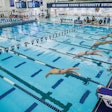![[Photos courtesy of Clovis West High School]](https://img.athleticbusiness.com/files/base/abmedia/all/image/2019/08/ab.aquatics719_feat.png?auto=format%2Ccompress&q=70&w=400)
Aquatics facility operators are always looking for ways to fill the water during more hours of the day. But for large rectilinear pools, introducing recreational programming isn't always the best way to diversify use. Clovis West High School in Fresno, Calif., which has hosted the California Interscholastic Federation State Swimming & Diving Championships for five consecutive years, has a laser focus on competition aquatics — and still manages to keep the pool in use more than 12 hours a day, six days a week.

Hosting the championships
The Clovis Olympic Swim Complex is a 1980s-era outdoor facility with a 50-meter pool, a 25-meter dive well with boards and platforms in a range of 1 to 10 meters, and an instructional pool. Over the course of the two-day CIF championship event in May, the complex hosted roughly 3,000 people, including competitors, coaches, officials and spectators.
According to Clovis West athletic director Matt Loggins, coordinating so many teams and events takes a lot of planning, preparation and logistics — and a few facility upgrades. During his tenure, the school has installed new bleachers along the east side of the 50-meter competition pool that can seat around 1,500 spectators at a time for large high school and collegiate swim meets and water polo tournaments. Other additions he's seen include the installation of a new outdoor video board for spectators, as well as non-slip matting on the pool deck and various specialized timing equipment. The complex also periodically rents portable shade structures from a local provider.
"With our facility, we want to make sure that we get as many people as possible close to those eight lanes on the competition end of the pool, so we put in bleachers," says Loggins. "We also put in multilevel press and VIP and coaching areas along the south end of the pool to frame the competition end. And then it does get warm here in the Central Valley, so we bring in shade covering over all the bleachers and block areas. The goal is for the athletes to come in and they don't need anything. We have everything covered, and we just want them to come in and compete to their very best."
With his team of like-minded coaches, teachers and administrators (Loggins serves as the logistics director for the championship meet, while the Clovis West head swim coach serves as competition director, and the district athletic director and assistant superintendent of educational services help with planning and preparations), Loggins does his best to accommodate up to 400 different schools at the aquatic center and makes sure everyone has what they need, whether it be a large team of up to 15 or a smaller contingent of one or two swimmers.
"We don't have a special staff for events, so we add on some additional duties," he says. "The four of us meet regularly throughout the year and we just divvy it out and tackle it and get it done. Set-up can be a challenge, but I think after year five we kind of have a blueprint and a plan."

Out-of-water accommodations
Hosting so many user groups in such a condensed period of time requires setting up temporary support spaces in addition to the connected locker rooms, showers and restrooms at the west end of the Clovis Olympic Swim Complex. The west end also connects to the school gym and courtyard, with a wrestling room directly off the pool deck that gets reallocated as a hospitality room for officials during the championships. The gymnasium itself is used as a team area, where competitors make use of the air conditioning and a live feed of the competition.
"We livestream the competition so the athletes are able to be in a climate-controlled environment and still know what races are going without having to be on deck," says Loggins. "That's one way we allow for a greater number of spectators to be closer to the competition — we remove the coaches and athletes."

Coordinating user groups
Besides being filled to capacity for high-profile annual competition events, the pools at Clovis West are used regularly for high school swim team practices and physical education classes — including sport-specific classes for swimming and water polo. "Before school it's utilized by our high school swim team, as well as our high school polo team, just depending on where we're at in the season," Loggins says. "Then after school our teams are practicing usually until about 5 or 5:30."
The district also operates a USA Swimming-affiliated swim club through the facility, which generally fills the hours between 5 and 9 at night, and the local dive club fills in any other gaps. "It's kind of a joint thing, where it's our campus and it's our site pool so we have some autonomy over it, but then the district has some shared autonomy."
The pools are open to the community only through established competition programs. Says Loggins, "It's not open for general swim. It's pretty organized." As one of five high schools in the Clovis Unified School District, each of which has at least a 30-meter pool, in addition to aquatics facilities at the district's junior highs, Clovis West has the freedom to specialize because the burden of use is shared. "There's a lot of water to be managed in Clovis Unified," Loggins says. "There are areas that do open for the public; we're just not one of those sites."
The Clovis Olympic Swim Complex's revenue comes from year-round club use more than the annual CIF championships, which Loggins considers a labor of love. "It's about allowing our kids to wake up in their own beds and come compete in a pool they're used to," he says, "and hopefully do very well."
Long-awaited Elk Grove Aquatics Center opens in time for summer 2019Competitive high school swimmers in the city of Elk Grove, Calif., were happy to kick off the summer with a brand-new aquatics facility. The Elk Grove Aquatics Center officially opened May 25, after a yearlong delay due to weather and construction mishaps. The center broke ground more than two years ago and was originally intended to open in May 2018. The $42 million project features a 50-meter competition lap pool, a six-lane shallow-water fitness and instruction pool, a separate recreation pool and two water slides measuring 30 feet, in addition to a concessions stand and rentable party space. The municipal facility will provide a daily practice space for both the Elk Grove swim team and aquatics club. Elk Grove city manager Jason Behrmann told the Elk Grove Citizen that the center was "a long time coming. The city has been working on this for over a decade and it's changed a lot over the years," he said. "When I came, it was a facility that was over budget, both from a construction standpoint, as well as in operation. We re-envisioned it to make it a facility that we could not only afford to build, but could afford to operate without cutting corners." Long-term goals for the project site also include a nearby community center and a pedestrian-friendly public commons. |
This article originally appeared in the July | August 2019 issue of Athletic Business with the title "The Clovis Olympic Swim Complex: In use dawn to dusk." Athletic Business is a free magazine for professionals in the athletic, fitness and recreation industry. Click here to subscribe.





































